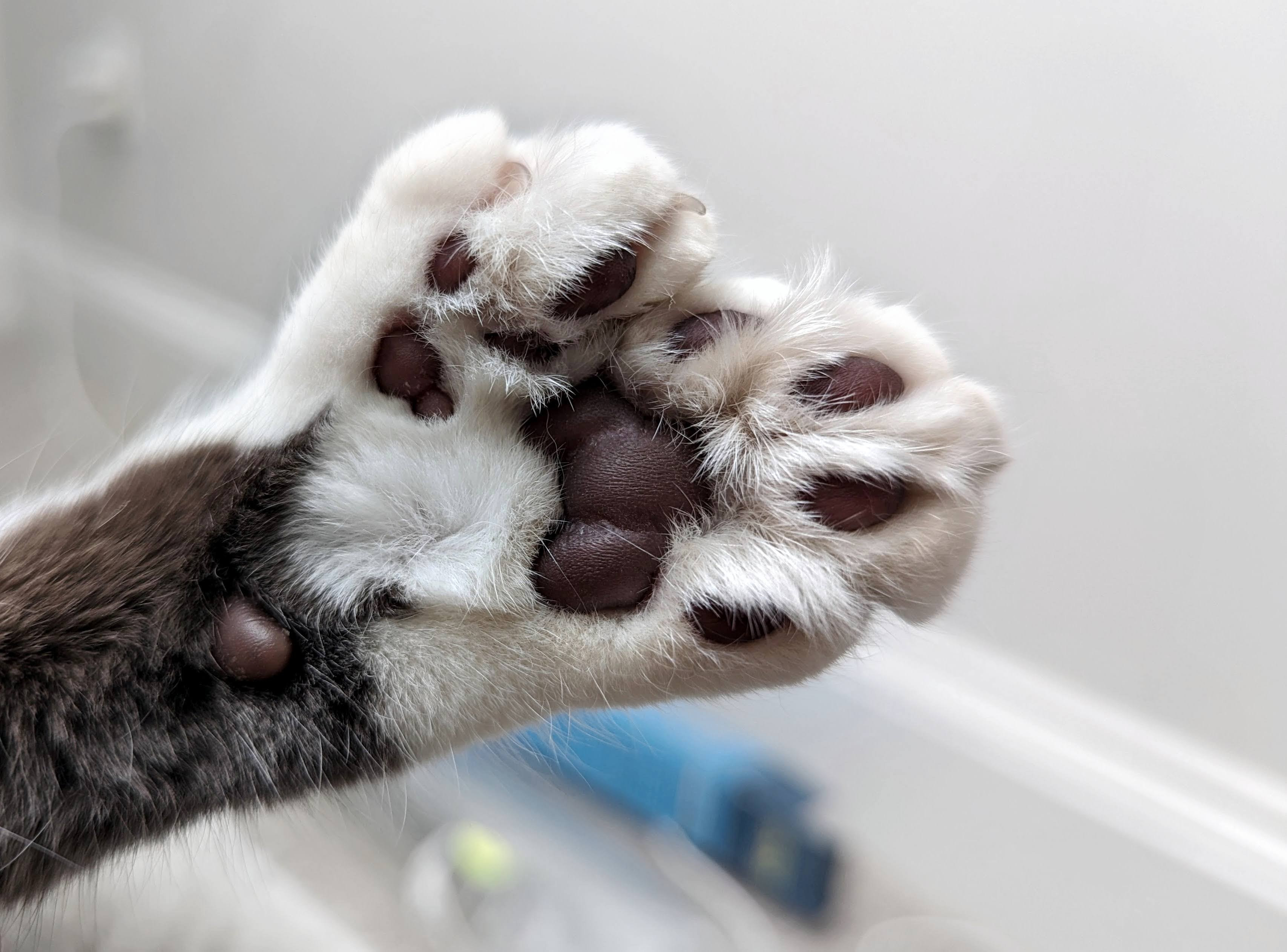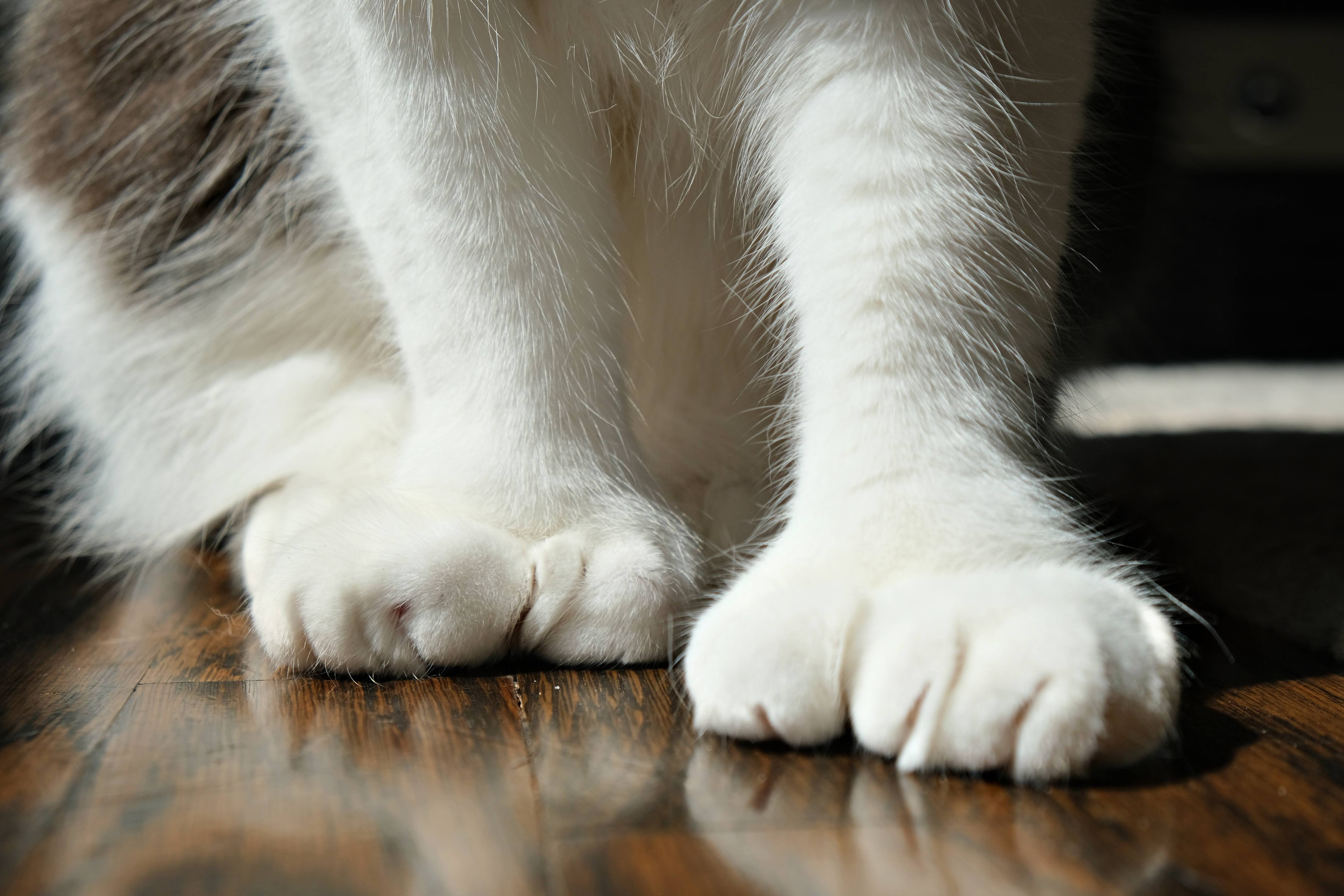If you’ve ever been charmed by a cat’s paws, prepare to be even more intrigued. Some cats are born with a delightful anomaly: extra toes! These fascinating felines are known as Polydactyl Cats, a term derived from Greek meaning “many digits.” You might also hear them called Hemingway cats, mitten cats, snowshoe cats, or thumb cats – all affectionate nicknames for these unique-pawed wonders.
But what exactly causes this adorable quirk? How many toes can a polydactyl cat actually have? And does having extra toes require any special care? Let’s delve into the captivating world of polydactyl cats and uncover the answers.
What Exactly is a Polydactyl Cat?
 black and white cat paw with extra toes
black and white cat paw with extra toes
Normally, a cat boasts a total of 18 toes: five on each front paw and four on each back paw. This count includes a dewclaw on each front paw, which is absent on the hind paws. However, a polydactyl cat deviates from this standard, sporting one or more additional toes on any of their paws.
The term “polydactyly” itself simply refers to the presence of these extra digits, whether it’s a single additional toe or multiple. “Extra toes can manifest on both the front and back limbs,” explains Dr. Anita Patel, DVM, a veterinarian and Area Medical Director at IndeVets. These extra toes most commonly develop on the inner side of the paw, the pre-axial or “thumb” side. Less frequently, they appear on the outer side (post-axial or “pinky” side) or even in the middle (meso-axial). Intriguingly, these extra digits don’t always appear symmetrically, meaning a cat might have a different number of extra toes on each paw.
Just how many toes can a cat have? The record is held jointly by two remarkable felines: Jake, an orange tabby, and Paws from Minnesota. Both boast an astonishing seven digits on each paw, totaling 28 toes! These extraordinary cats exemplify the fascinating extent of polydactyly in the feline world.
The Genetics Behind Polydactyly: Why Some Cats Have Extra Toes
The secret behind polydactyl cats lies in their genes. As Dr. Patel points out, genetics play a pivotal role in this trait. Polydactylism is an autosomal dominant trait, although with some complexities in its expression. This means that a kitten only needs to inherit the polydactyly gene from one parent to potentially be born with extra toes.
However, the genetic mechanisms determining the number of extra toes are not fully understood. “The genetic basis of polydactylism is complex,” clarifies Dr. Alejandro R. Caos, DVM, a small-animal veterinarian at The Vets. It’s a dominant trait characterized by incomplete penetrance and variable expression. This intricate genetic interplay explains the wide range of toe configurations seen in polydactyl cats, from just one extra digit to many.
The origins of polydactyly in cats are also shrouded in some mystery. One theory suggests that polydactyl cats might have been brought to the Americas by early settlers and sailors. The reasoning? Their larger paws could have made them exceptionally adept rodent hunters on ships and in port towns.
While extra toes might seem advantageous, enhancing balance, grip, or hunting skills, Dr. Caos emphasizes that any such benefits are individual and not guaranteed. He believes polydactyly in cats is more likely a result of genetic chance rather than a crucial evolutionary adaptation. “Polydactylism is not considered a critical adaptation for cats’ survival in the wild,” he states. “Most cats, regardless of their toe count, are well-suited to their natural environments.”
Are Polydactyl Cats Rare? Prevalence and Inheritance
Despite their unique feature, polydactyl cats are not considered rare. Dr. Caos explains the relatively common occurrence: “When a polydactyl cat mates with a non-polydactyl cat, each kitten has a 50% chance of inheriting the polydactyl gene.” If both parents are polydactyl, the likelihood of their kittens being polydactyl significantly increases.
The most frequently observed form of polydactyly involves just one or two extra toes on the front paws, often resembling thumbs or mittens. Cats with a significantly higher number of extra toes, like the record-holders Jake and Paws, are considered more unusual, but the trait itself is certainly not uncommon in the feline population.
Polydactyl Cat Breeds and the Hemingway Connection
 white cat paws with thumbs
white cat paws with thumbs
While polydactyly can appear in any cat breed, certain breeds are more predisposed to it. The Maine Coon and Pixie-bob breeds are notably more likely to exhibit extra toes compared to other cat breeds. “Maine Coon cats are recognized for their substantial size and tufted ears, and the presence of extra toes enhances their distinctive appearance,” notes Dr. Caos.
You might also encounter the term “American Polydactyl,” but it’s important to clarify that this isn’t a recognized breed. Instead, it refers to cats descended from polydactyl populations, particularly those originating in Key West, Florida. This brings us to the famous “Hemingway cats.” The renowned novelist Ernest Hemingway, a former Key West resident, famously owned a six-toed cat named Snow White. Snow White and her descendants thrived at Hemingway’s estate, passing on the polydactyly gene through generations. Today, Hemingway’s former residence in Key West is a museum and a sanctuary for over 60 polydactyl cats, affectionately known as Hemingway cats or Papa cats, in honor of the author.
Caring for Your Polydactyl Cat: Special Considerations
Generally, caring for a polydactyl cat is very similar to caring for any cat with the standard 18 toes. However, there are a few specific aspects to keep in mind to ensure your multi-toed feline stays happy and healthy.
Nail Care for Extra Toes
Polydactyl cats have more nails, and some of these extra nails might not make contact with the ground, meaning they won’t wear down naturally. This puts them at a higher risk of nail overgrowth. Overgrown nails can lead to discomfort, infections, and the nails can easily get snagged on carpets or furniture. Regular nail trimming is therefore crucial to prevent these issues. Make sure to include all those extra toes in your nail care routine!
Paw Hygiene and Cleaning
“The extra toes on polydactyl cats can create additional spaces between the toes where dirt, debris, or even litter can accumulate,” explains Dr. Caos. Regularly inspecting your polydactyl cat’s paws and gently wiping them clean as needed will help prevent any build-up and maintain good paw hygiene.
Mobility Considerations
In most cases, polydactyl cats experience no mobility problems due to their extra toes. However, if your cat has particularly large or unusually formed extra toes, it’s wise to monitor their movement. They should be able to walk, run, and jump comfortably without any signs of pain or difficulty.
“If you observe any limping, favoring of certain paws, or changes in their usual mobility,” advises Dr. Caos, “it’s best to consult with a veterinarian for a thorough examination.” In rare instances, if extra toes are causing significant problems, surgical removal might be considered.
Polydactyl cats are truly captivating creatures, adding an extra touch of charm to the already endearing feline form. With their unique paws and fascinating genetic story, they remind us of the wonderful diversity within the animal kingdom. Whether you call them polydactyl cats, Hemingway cats, or simply cats with thumbs, these multi-toed marvels are sure to capture the hearts of cat lovers everywhere.
